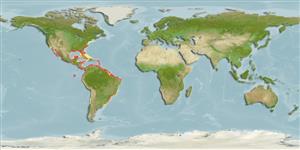Elasmobranchii (haaien en roggen) (sharks and rays) >
Carcharhiniformes (Ground sharks) >
Sphyrnidae (Hammerhead, bonnethead, or scoophead sharks)
Etymology: Sphyrna: Probable misspelling of sphyra (Gr.), hammer, referring to their hammer-shaped heads (See ETYFish); tiburo: From tiburon, Spanish for shark, a name given by 16th- and 17th-century navigators to one or more large species of shark (See ETYFish).
More on author: Linnaeus.
Environment: milieu / climate zone / depth range / distribution range
Ecologie
marien; brak water rifbewoner; diepte 10 - 80 m (Ref. 244), usually 10 - 25 m (Ref. 9253). Subtropical; 45°N - 36°S, 121°W - 32°W (Ref. 55302)
Western Atlantic: North Carolina, USA to southern Brazil, including Cuba and the Bahamas. Caribbean and Gulf of Mexico; rare in Bermuda (Ref. 26938). Eastern Pacific: southern California, USA to Ecuador.
Lengte bij maturiteit / Grootte / Gewicht / Leeftijd
Maturity: Lm 85.0, range 80 - 90 cm
Max length : 150 cm TL mannelijk / geslacht onbekend; (Ref. 5217); common length : 80.0 cm TL mannelijk / geslacht onbekend; (Ref. 5217); max. gepubliceerd gewicht: 10.8 kg (Ref. 40637); max. gerapporteerde leeftijd: 12 Jaren (Ref. 26248)
Front of head semicircular in outline. No other hammerhead has front of head in semicircle. (Ref. 26938).
Found on the continental and insular shelves, on inshore and coastal areas, over mud and sand bottoms, also on coral reefs. Often occur in shallow water including estuaries, shallow bays and over coral reefs (Ref. 9987). Spends night time hours on shallow grass flats, searching for nocturnally active invertebrate prey, moves into deeper water during the day (Ref. 27549). Feed mainly on crustaceans, also on bivalves, octopi, and small fish. Viviparous, with 6 to 9 young per litter. Size at birth about 35 to 40 cm. Not territorial. Always occurs in small groups. Considerable sexual segregation occurs. Shows diel rhythm of activity. Utilized for human consumption and processed for fishmeal.
Viviparous, placental (Ref. 50449), with 6 to 9 young per litter. Size at birth about 35 to 40 cm.
Compagno, L.J.V., 1984. FAO Species Catalogue. Vol. 4. Sharks of the world. An annotated and illustrated catalogue of shark species known to date. Part 2 - Carcharhiniformes. FAO Fish. Synop. 125(4/2):251-655. Rome: FAO. (Ref. 244)
Status op de Rode Lijst van het IUCN (Ref. 130435: Version 2024-2)
Gevaar voor de mens
Harmless
Gebruik door de mens
Visserij: commercieel; sportvis: ja
Tools
Speciale rapporten
Download XML
Internetbronnen
Estimates based on models
Preferred temperature (Ref.
123201): 21.8 - 28, mean 25 °C (based on 368 cells).
Fylogenetische diversiteitsindex (Ref.
82804): PD
50 = 0.5029 [Uniqueness, from 0.5 = low to 2.0 = high].
Bayesian length-weight: a=0.00204 (0.00116 - 0.00361), b=3.10 (2.94 - 3.26), in cm total length, based on LWR estimates for this species & (Sub)family-body (Ref.
93245).
Trofisch niveau (Ref.
69278): 3.9 ±0.0 se; based on diet studies.
Weerstandsvermogen (Ref.
120179): Zeer laag, minimale populatieverdubbelingstijd meer dan 14 jaar (K=0.17-0.34; tm=3; tmax=12; Fec=3).
Fishing Vulnerability (Ref.
59153): High vulnerability (57 of 100).
Nutrients (Ref.
124155): Calcium = 6.95 [1.35, 35.56] mg/100g; Iron = 0.372 [0.090, 1.111] mg/100g; Protein = 21.3 [19.1, 23.4] %; Omega3 = 0.115 [0.044, 0.282] g/100g; Selenium = 15.4 [4.2, 49.6] μg/100g; VitaminA = 16.5 [4.9, 59.7] μg/100g; Zinc = 0.52 [0.24, 1.15] mg/100g (wet weight);
